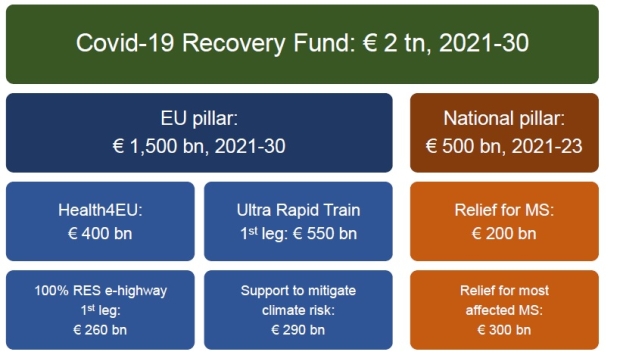How to Spend it
The Recovery Fund recently proposed by the EU Commission marks a sea-change in European integration. Yet it will not be enough to meet the challenges Europe faces. In a joint Policy Note the Macroeconomic Policy Institute (IMK) in Düsseldorf, the Paris-based Observatoire français des conjonctures économiques (OFCE) and the Vienna Institute for International Economic Studies (wiiw) propose a 10-year, €2 trillion investment programme focusing on public health, transport infrastructure and energy/decarbonisation. It would finance genuinely European projects so that the EU emerges stronger from the Covid-19 crisis.
- The Recovery Fund recently proposed by the EU Commission marks a sea-change in European integration. Yet it will not be enough to meet the challenges Europe faces. There has been much public debate about financing, but little about the sort of concrete projects that the EU should be putting public money into.
- Here we propose a 10-year, €2tn investment programme focusing on public health, transport infrastructure and energy/decarbonisation.
- It consists of two pillars. In a national pillar, Member States – broadly as in the Commission proposal – would be allocated €500bn. Resources should be focused on the hardest-hit countries and front-loaded: we suggest over a three-year horizon.
- The bulk of the money – €1.5tn – would be devoted to finance genuinely European projects, where there is an EU value added. We describe a series of flagship initiatives that the EU could launch in the fields of public health, transport infrastructure and energy/decarbonisation.
- We call for a strengthened EU public health agency that invests in health-staff skills and then facilitates their flexible deployment in emergencies, and is tasked with ensuring supplies of vital medicines (Health4EU).
- We present costed proposals for two ambitious transport initiatives: a dedicated European high-speed rail network, the Ultra-Rapid-Train, with four-routes cutting travel times between EU capitals and regions, and, alternatively, an integrated European Silk Road initiative that combines transport modes on the Chinese model.
- In the area of energy/decarbonisation we seek to “electrify” the Green Deal. We call for funding to accelerate the realisation of a smart and integrated electricity grid for 100%-renewable energy transmission (e-highway), support for complementary battery and green-hydrogen projects, and a programme, modelled on the SURE initiative, to co-finance member-state decarbonisation and Just Transition policies.
- The crisis induced by the pandemic, coming as it does on top of the financial and euro crises, poses a huge challenge. The response needs to take account of the longer-run structural challenges, and above all that of climate change. The European Union should rise to these challenges in the reform of an ambitious medium-run recovery programme, appropriately financed. An outline of such a programme is set out here by way of illustration, but many permutations and options are available to policymakers.
Suggested architecture of a European Covid-19 Recovery Programme
Note: The EU pillar (time period 2021-2030) includes: Health4EU agency costs of €20 bn p.a. plus health infrastructure support of €20 bn p.a. (i.e. two fifth of the health infrastructure gap of €50 bn p.a. for the countries with tight budgets); Ultra Rapid Train (alternatively a European Silk Road of similar costs) 1st half of the total €1.1 tn, i.e. €550 bn; 100% RES e-highway 1st half of the total €520 bn, i.e. €260 bn; remaining €290 bn in support to member state policies to mitigate climate risk.
Source: Own presentation.
Authors
Jérôme Creel, Observatoire Français des Conjonctures Economiques (OFCE/Science Po)
Mario Holzner, Vienna Institute for International Economic Studies (wiiw)
Andrew Watt, Macroeconomic Policy Institute (IMK/Hans Böckler Stiftung)

